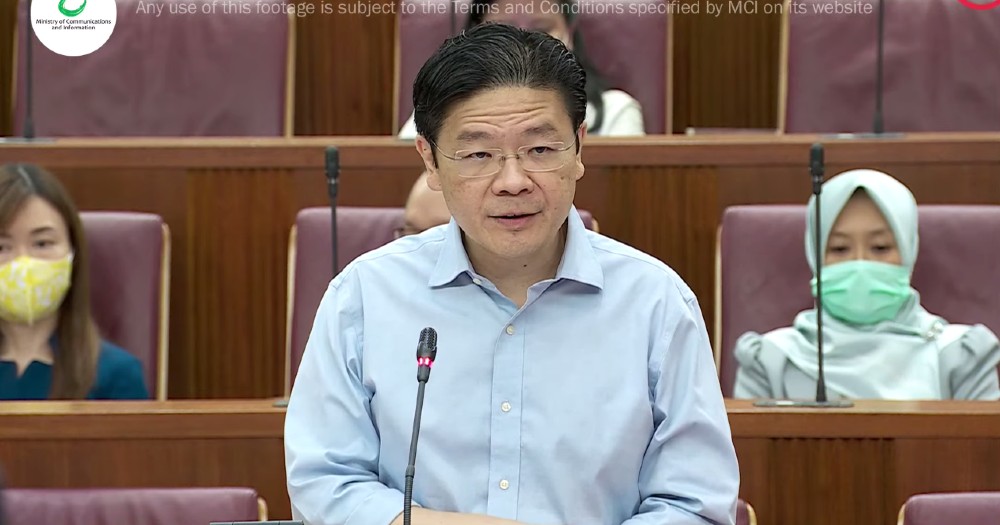Follow us on Telegram for the latest updates: https://t.me/mothershipsg
The net loss of S$7.4 billion recorded by the Monetary Authority of Singapore (MAS) for the financial year that ended on Mar. 31 reflected a currency translation effect, Finance Minister Lawrence Wong said in Parliament on Aug. 1.
Wong, who is also Deputy Prime Minister, was responding to questions posed in Parliament about the context to the loss reported by MAS and whether the loss would affect the government's budget position.
What is the currency translation effect?
According to Wong, it is "the effect of translating the foreign currency value of the official foreign reserves (OFR) into Singapore dollars."
The minister added:
"The negative currency translation effect is not relevant to MAS's investment performance, which is measured in foreign currencies. It also has no bearing on the international purchasing power of the OFR or on MAS's conduct of monetary policy."
Wong highlighted that for the financial year of 2021 to 2022, MAS made investment gains of S$4 billion on the OFR.
However, these investment gains were outweighed by the negative currency translation effect of S$8.7 billion arising from a stronger Singapore dollar.
Wong explained that the strengthening of the Singapore dollar, against several foreign currencies in which the OFR are held, was due to MAS tightening its monetary policy in October 2021 and January 2022.
This meant a loss when the OFR was reported in Singapore dollars, he said.
Negative currency translation effect has "no implication" for Singapore's reserves purchasing power
Wong pointed out further that a negative currency translation effect has "no implication" for the international purchasing power of the OFR.
He elaborated, "Given the purpose of the OFR in safeguarding the international purchasing power of the Singapore dollar, it is the foreign currency value rather than the Singapore dollar value of the OFR that matters."
In addition, MAS's net loss in Singapore dollar terms has "no implications" for its conduct of monetary policy.
Wong explained:
"The aim of MAS's monetary policy is to secure low and stable inflation as the basis for sustained growth over the medium term. MAS, as members (of parliament) know, conduct an exchange rates-centred monetary policy managing the Singapore dollar against a basket of currencies of Singapore's major trading partners.
When inflationary pressures build up, as they have over the past year, MAS allows the trade-weighted exchange rate to appreciate faster.
Negative currency translation effects do not have any bearing on MAS's ability to manage the exchange rate; rather they are a consequence of MAS's conduct of exchange rate policy."
What about the impact of the net loss on the government's budget position?
MAS's reported net loss has no impact on the Net Investment Returns framework
Here, Wong added that the "overarching mandate" of MAS is to ensure macro-economic stability.
'The government does not expect MAS to deviate from this mandate in order to maximise its contribution to the government," he said.
As for how MAS contributed to the government's budget, Wong elaborated that this was done in two ways.
With regard to the first method, Wong said that under the Net Investment Returns (NIR) framework, the government can spend up to 50 per cent of the expected long-term real return on the net assets invested by MAS, GIC and Temasek.
"The NIR investment returns framework is designed to provide a steady, sustainable stream of income to help meet the government's expenditure needs," he said.
The NIR framework is also based on the long-term expected returns of the three investment entities and is therefore not affected by their short term performance.
"MAS's reported net loss in the last financial year has no impact on the NIR that is available to the government," Wong noted.
MAS makes contributions to the government in lieu of corporate income tax
As for the second method, MAS makes contributions to the government in lieu of corporate income tax, similar to other statutory boards, according to the minister.
"This is based on 17 per cent of the net profit for the year after offsetting cumulative losses from the previous financial years," he highlighted.
For MAS, the government is cognisant of the fact that its contributions will vary "considerably" from year to year due to the combined effect of currency translation and investment returns on its balance sheet.
He said:
"And this is why since financial year 2019, the government has smoothened the revenue volatility by requiring the annual contributions made by MAS to be paid in equal proportions over a period of three years.
This means that even though MAS recorded a net loss for FY 2021/22, the government will receive S$1.1 billion from MAS based on the contributions accrued for the previous two financial years, when MAS recorded net profits."
Top screenshot via MCI/YouTube
If you like what you read, follow us on Facebook, Instagram, Twitter and Telegram to get the latest updates.
